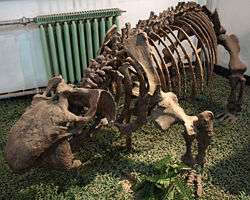Sinokannemeyeria
| Sinokannemeyeria Temporal range: late Early Triassic | |
|---|---|
 | |
| Restoration of Sinokannemeyeria | |
| Scientific classification | |
| Kingdom: | Animalia |
| Phylum: | Chordata |
| Class: | Synapsida |
| Order: | Therapsida |
| Suborder: | Anomodontia |
| Infraorder: | Dicynodontia |
| Family: | Kannemeyeriidae |
| Genus: | Sinokannemeyeria |

A specimen of Sinokannemeyeria yingchiaoensis, on display at the Paleozoological Museum of China.
Sinokannemeyeria was a large (about 6 feet (1.8 m) long and weighing 250 pounds), long snouted, Chinese dicynodont with downward-pointing tusks that grew from bulbous projections on its upper jaw. The muscle attachment sites on the back of the skull were quite small, which suggested that Sinokannemeyeria did not have powerful skull muscles for shearing plants, unlike other dicynodonts. Most dicynodonts chopped up food by sliding their lower jaws backward and forward. Sinokannemeyeria fed by tearing plant material with the front of the snout.
Sinokannemeyeria and the other kannemeyeriines descended from ancestors similar to Lystrosaurus.
See also
| ||||||||||||||||||||||||||||||||||||||||||||||||||||||||||||||||||||||||||||||||||||||||||||||||||||||||||||||||||||||||||||||||||||||||||||||||||||||||||||||||||||||||||||||||||||||||||||||||||
This article is issued from Wikipedia - version of the Sunday, February 14, 2016. The text is available under the Creative Commons Attribution/Share Alike but additional terms may apply for the media files.